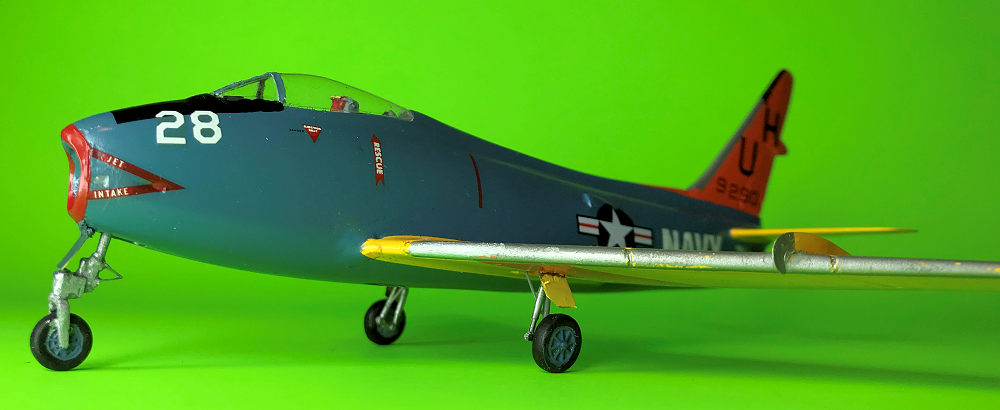
| KIT #: | 72008 |
| PRICE: | $20.00 'Used' |
| DECALS: | One option |
| REVIEWER: | Joel Hamm |
| NOTES: |
Very short run |

| HISTORY |
The recent release by the Sword company of 3 Fury variants spurred oodles of histories of this aircraft on MM and other sites; so I’ll simply say that it is the culmination of the US Navy’s program to carrier-ize the F-86 Sabre Jet.
For you young whippersnappers who have no inkling of the hardships we oldsters endured just so you could now whine about rivets and raised panel lines. This is non-scholarly, non authentic, non definitive; derived my own failing memory: Modeling seemed to take off around 1980, as baby boomers segued into retirement and second childhood; seeking a use for the big bucks acquired in the years when a fellow could turn a college degree into a career. Those glory days had also extended even unto the second generation; so empty nests remained empty, and Grandpa and Grandma did not have to slave at Wal-Mart supporting a house full of boomerangers and their whelps.
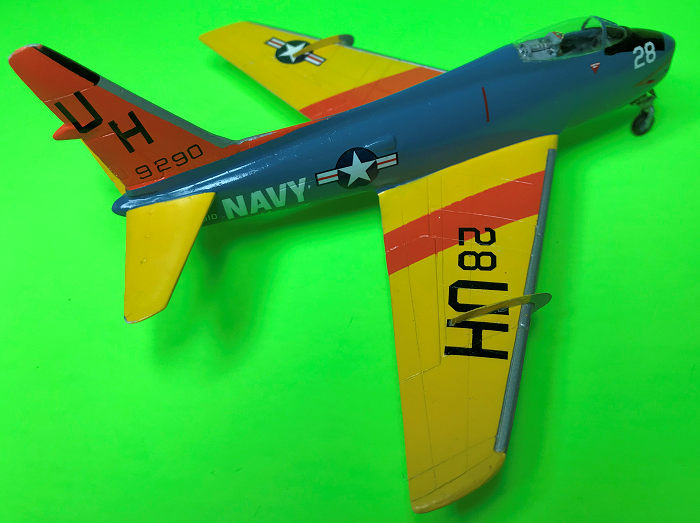 A few
forward thinking entrepreneurs realized they could grab some of those free
floating greenbacks by offering modelers something more than Meezeschmits and
Mustangs. First came the vacuformers; but that genre never caught on. Then,
apparently, technology became available for the average garage putterer to
produce injection molded kits. A fist-full of companies sprang up, mostly in
Merry Olde Eng-a-land, turning out subjects we had never dared dream of.
Competing with Merlin were: Pegasus, Twelve-Squared, Meikraft, Allied Research
North, Mach II, and a batch of others. Crude would be the kindest description of
their products. Only the basic fuselage and wing parts were useable, but only
after extensive surgery. Appurtenances had to be scrounged or scratch built.
Their transparencies spurred a world-wide search for the elusive, OOP Matel Vacu-form
toys. Just about all these firms folded in the 90’s, as high quality
replacements became available from the Czech “Second Generation” short run
injectors, and the resin pourers, whose newly spawned techniques allowed limited
interest subjects to be produced without investing untold schmolares in
precision milling and injection machines.
A few
forward thinking entrepreneurs realized they could grab some of those free
floating greenbacks by offering modelers something more than Meezeschmits and
Mustangs. First came the vacuformers; but that genre never caught on. Then,
apparently, technology became available for the average garage putterer to
produce injection molded kits. A fist-full of companies sprang up, mostly in
Merry Olde Eng-a-land, turning out subjects we had never dared dream of.
Competing with Merlin were: Pegasus, Twelve-Squared, Meikraft, Allied Research
North, Mach II, and a batch of others. Crude would be the kindest description of
their products. Only the basic fuselage and wing parts were useable, but only
after extensive surgery. Appurtenances had to be scrounged or scratch built.
Their transparencies spurred a world-wide search for the elusive, OOP Matel Vacu-form
toys. Just about all these firms folded in the 90’s, as high quality
replacements became available from the Czech “Second Generation” short run
injectors, and the resin pourers, whose newly spawned techniques allowed limited
interest subjects to be produced without investing untold schmolares in
precision milling and injection machines.
| THE KIT |
Why do I continue torturing myself with ancient Merlin short-runners? The question has occupied many expensive therapy sessions. The best – the only – answer is that, like banging one’s head against the wall, it feels so good when you stop. The other topic discussed from the shrink’s couch is an infatuation with the sexy Sabre Jet, and an obsession with collecting, if not a perfect, at least a decent 1/72 model of each variant. One of the least decent sitting on the Early Jet Shelf is an Emhar FJ-4, with a mis-shaped canopy that fits only by grace of a tumorous filler glob.
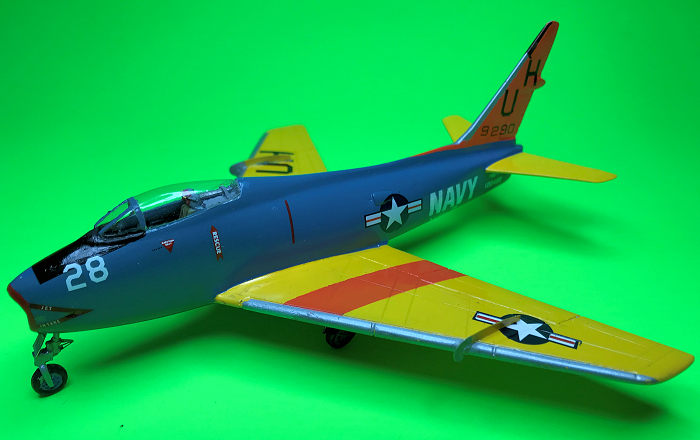 The
prospect of finding a replacement seemed unlikely, until discovery of
OldModelKits .com, which re-sells collections of out of production and rare
model kits of all types. Their first possibility was a Fury by Revell and/or
Matchbox; but MM posters warned that this was a re-boxed Emhar. Then a
previously unknown Merlin rendering appeared on line. For $20 I figured why not
– how bad could it be? Modeling skills had atrophied over a 3 year hiatus in the
hobby; so here was a chance to get back to snuff on an expendable project.
The
prospect of finding a replacement seemed unlikely, until discovery of
OldModelKits .com, which re-sells collections of out of production and rare
model kits of all types. Their first possibility was a Fury by Revell and/or
Matchbox; but MM posters warned that this was a re-boxed Emhar. Then a
previously unknown Merlin rendering appeared on line. For $20 I figured why not
– how bad could it be? Modeling skills had atrophied over a 3 year hiatus in the
hobby; so here was a chance to get back to snuff on an expendable project.
How bad could it be? It could be Merlin Bad. I had expected – hoped for – some improvement over the years, but forgot that the kit had been made in 1987. Quality was somewhat better than that of earlier kits. Plastic was thinner, with the proper hardness of styrene, rather than the consistency of amalgamated gorgonzola cheese and ear wax typical of erstwhile low pressure injections. Surfaces lacked distiguishable detail, but also the graininess and greasy splotches that plagued those cottage industry offerings.
| CONSTRUCTION |
After having their mating surfaces sanded flat, the fuselage halves went together with a reasonably proper shape; except that the intake could not be corrected to the characteristic squareness. First of many compromises. Lots of Pb shot got stuffed around trunking made from a ball point pen barrel. Wing planform looked OK, but camber belonged to a Piper Cub. Much sanding, top and bottom, followed by panel re-scribing, turned it into a more-or-less jet-foil.
Bulbous blob horizontal stabs were too far gone for
that fix. One of the things Mr. Merlin did right was include a 1/72 3-view
drawing of the subject on the otherwise useless instruction sheet. I Xeroxed
this, c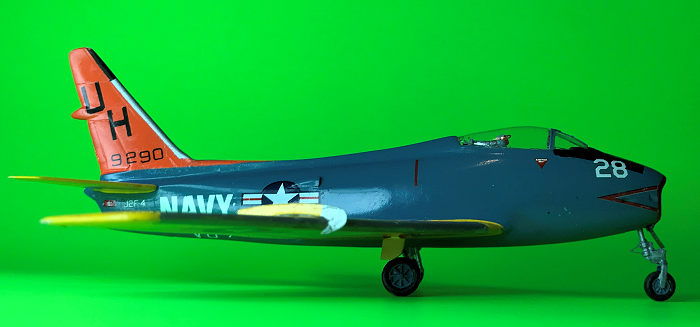 ut
out the tailfin pics, and pasted them to a set of lean, crisp tail feathers from
the spares bin. They may have come from a Hase Phantom. Hey – from one F4 to
another. Sanding down to the outline produced the correct shape. Control hinge
lines were wrong, but recall what was said about compromises. That treatment, in
turn, could not be applied to the obese monstrosity vertical fin, since no
suitable starting slab was available. Extensive sanding brought the part into
semi-compliance with the camber of a vertical stabilizer.
ut
out the tailfin pics, and pasted them to a set of lean, crisp tail feathers from
the spares bin. They may have come from a Hase Phantom. Hey – from one F4 to
another. Sanding down to the outline produced the correct shape. Control hinge
lines were wrong, but recall what was said about compromises. That treatment, in
turn, could not be applied to the obese monstrosity vertical fin, since no
suitable starting slab was available. Extensive sanding brought the part into
semi-compliance with the camber of a vertical stabilizer.
According to Web photos, the rudder is supposed to have stiffeners. There was no way to do that until many months later when Sword’s FJ-2/3 arrived with just such an optional part that would not be used on the selected variant. By then accuracy was so far gone that naught would be gained by a rudder-ectomy.
The whole project hinged on finding or forming a replacement canopy. I did a minor clean up on the too-wide, too-long, too-high, too-rough, too-opaque kit canopy, then vacu-formed a female mold over it. The female begat a male made of Durham’s Rock Hard Wood Putty. That was smoothed and sanded to fit the cockpit opening, then went back on the vacu-rig to melt-suck a new bubble top, perfect except for wind screen framing that was added from strips of pre-painted foil HVAC tape. The new part was heavily Futured, or Pledged, or Kleered, or whatever is the current name of that gift-of-the-gods acrylic concoction.
| COLORS & MARKINGS |
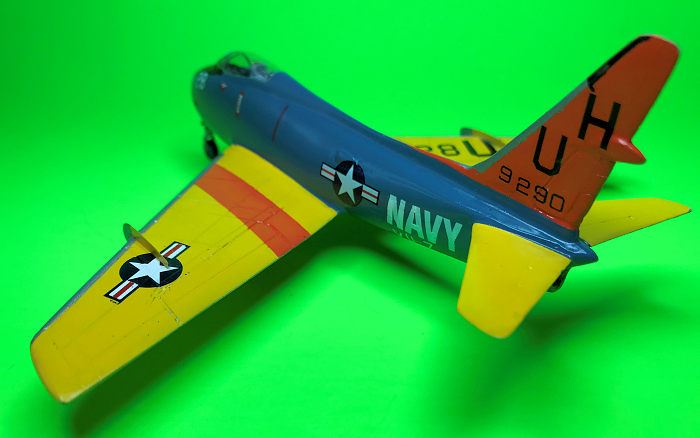 This build
was begun with the purpose of proving that a sow’s ear model could be saved, or
at least disguised by, a silk purse jazzy-snazzy paint job. When they were not
mucking about with dull gray and white, or hiding under the current
why-even-bother-to-mark-it low visibility liveries, the US Navy knew a thing or
two about snazzy. I mean, look at what they did with their 1930’s ‘tweeners.
That gaudy yellow-wingedness was brought back in the ‘50’s to clothe airplanes
assigned to their utility squadrons.
This build
was begun with the purpose of proving that a sow’s ear model could be saved, or
at least disguised by, a silk purse jazzy-snazzy paint job. When they were not
mucking about with dull gray and white, or hiding under the current
why-even-bother-to-mark-it low visibility liveries, the US Navy knew a thing or
two about snazzy. I mean, look at what they did with their 1930’s ‘tweeners.
That gaudy yellow-wingedness was brought back in the ‘50’s to clothe airplanes
assigned to their utility squadrons.
A Web search turned up a few photos of the real thing; but also a posting on Britmodeler.com of a 1/48 Grand Phoenix rendition begging to be copied in 1/72. Yellow, orange, and red came straight out of Testors little square bottles. Fuselage blue was eyeballed from light blue grayed with a dollop of black.
Modeling skills were not the only thing that had atrophied during a several years lull in the hobby. The stash of spare decals had aged, withered, wrinkled, crinkled, cracked and yellowed. The project was not worth the investment of time and $$$ to order new sheets of insignia, letters, and numbers, so what emerged was a mish-moshed hodge-podge of close-enough’s. As I’ve repeatedly repeated – the name of this game was compromise. The wing and tail markings are close to what they should be; but the fuselage markings are utter balderdash. The “DANGER – JET INTAKE” chevrons are 2 different sizes and styles. The “RESCUE” arrow should read vertically instead of horizontally. The “NAVY” letters are too fat and were fashioned from stencil font with dabs of white paint to fill the blank spaces.
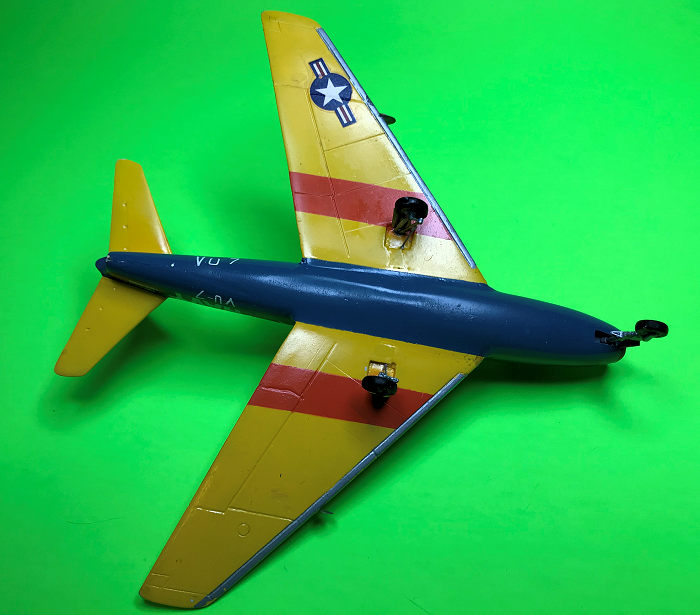 As the
decals got smaller the job got tougher. Mini-markings found fiendish delight in
exploding upon contact with water. Schpritzing with Testors Decal Saver made
matters worse by preventing them from sliding off their backing. Eventually, the
supply gave out of necessary characters and they had to be assembled from pieces
of others. Hence the crooked squadron identifiers where the V is 2 I’s leaning
together and the U is a decapitated 0. By the time I got that far aft
frustration had peaked. All that mattered was approximating the size and shape.
Beneath the tail feathers the serial numbers are different on either side and
bear no relation to the wing and tail ID’s. The aircraft type code on the
starboard side reads “J2F-4”. Close, but no cigar. The port side bears “F6U-1”.
At least the Vought Pirate was the Fury’s contemporary. One day, when patience
returns and the mailman brings some new Microscale sheets, I may paint over and
replace the worst offenders; though I’ll bet that even as I now ponder weak and
weary Sword is cooking up a top notch FJ-4.
As the
decals got smaller the job got tougher. Mini-markings found fiendish delight in
exploding upon contact with water. Schpritzing with Testors Decal Saver made
matters worse by preventing them from sliding off their backing. Eventually, the
supply gave out of necessary characters and they had to be assembled from pieces
of others. Hence the crooked squadron identifiers where the V is 2 I’s leaning
together and the U is a decapitated 0. By the time I got that far aft
frustration had peaked. All that mattered was approximating the size and shape.
Beneath the tail feathers the serial numbers are different on either side and
bear no relation to the wing and tail ID’s. The aircraft type code on the
starboard side reads “J2F-4”. Close, but no cigar. The port side bears “F6U-1”.
At least the Vought Pirate was the Fury’s contemporary. One day, when patience
returns and the mailman brings some new Microscale sheets, I may paint over and
replace the worst offenders; though I’ll bet that even as I now ponder weak and
weary Sword is cooking up a top notch FJ-4.
| FINAL BITS |
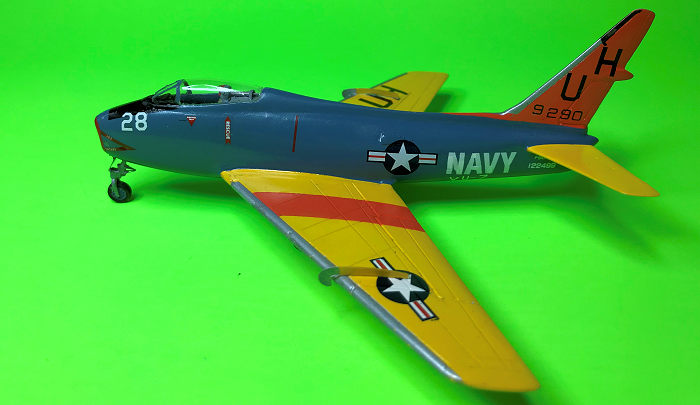 After the
cockpit had been busied up with whatever bits and pieces looked believable, the
canopy was affixed with a marvelous clear aqueous gel glue discovered at the
Everything-Costs-a-Dollar Store.
After the
cockpit had been busied up with whatever bits and pieces looked believable, the
canopy was affixed with a marvelous clear aqueous gel glue discovered at the
Everything-Costs-a-Dollar Store.
The molded-in wing fences, or the nubbins that represented them, had been removed in the initial re-shaping, and had to be replaced with Dremeled brass strips.
Prior to the Age of Resin, the cottage kit industry relied for its delicate parts on something called white metal. The OEM struts and wheels could be cleaned up, but better alternatives lay in waiting in the spares bin. Their painting and placement completed the project.
| CONCLUSIONS |
Of course it’s full of bungs, bloopers, and boogers. It’s a Merlin! But seriously, Folks, despite the jokes and barbs hurled at Merlin, Mach II, and their buddies, these rough, early oddities are a challenging sector of the hobby. For those passtimers unhappy with the growing trend toward simply assembling after-market resin, pre-colored, self adhesives, and laser cut paint masks, they offer a return to those thrilling days of yesteryear, when a model kit consisted of a rough-sawn chunk of balsa and a sheet of sandpaper; when a museum quality showpiece was the product of the modeler’s ingenuity and skill.
30 January 2018
Copyright ModelingMadness.com
If you would like your product reviewed fairly and fairly quickly, please contact the editor or see other details in the Note to Contributors.
Back to the Main Page Back to the Review Index Page Back to the Previews Index Page